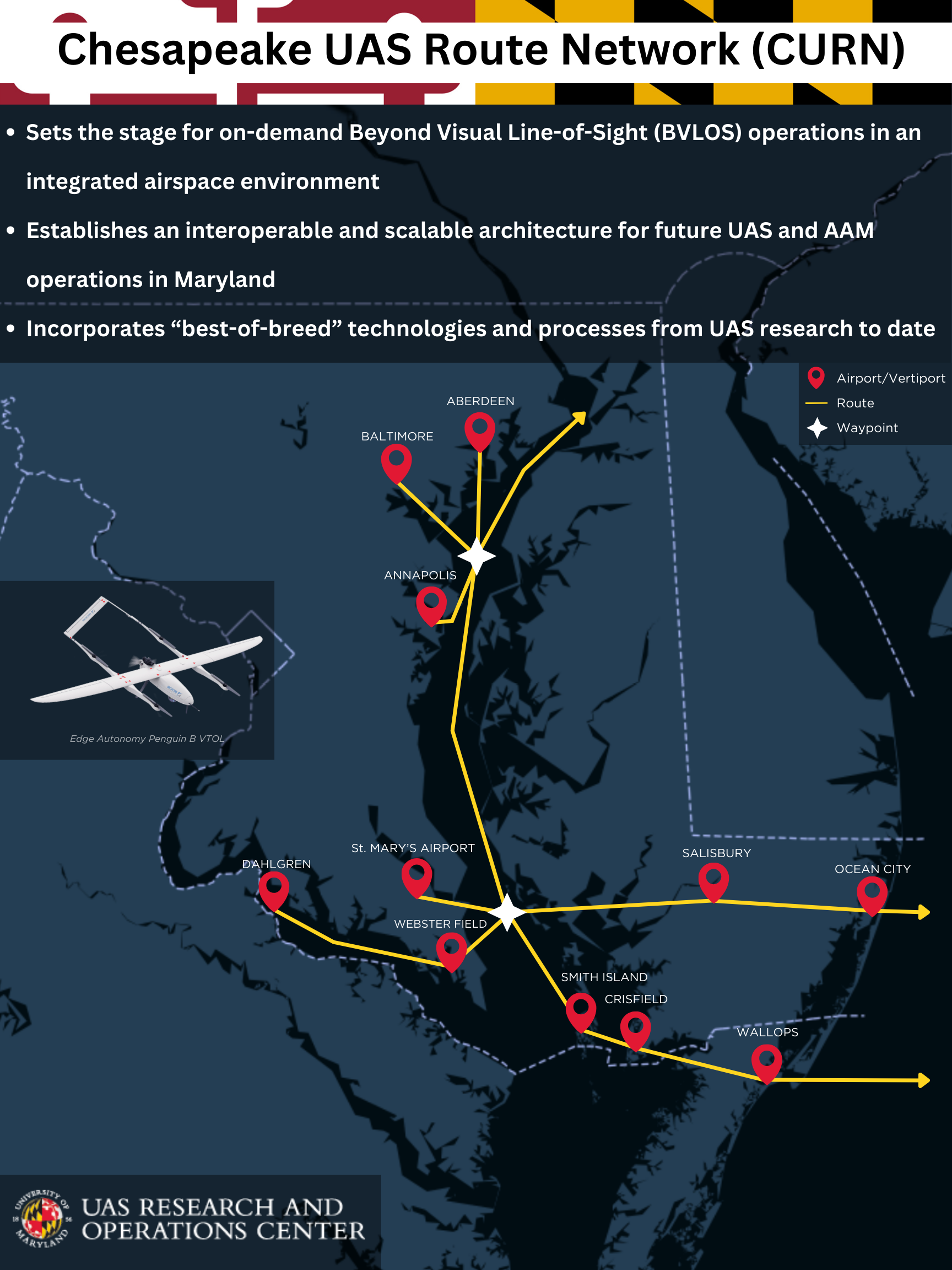CURN Project
View DemoPioneering the Future of Safe, Integrated Airspace Over the Chesapeake Bay
 The Chesapeake UAS Route Network (CURN) is an ambitious initiative to pioneer an ever-expanding network of long-range Beyond Visual Line of Sight (BVLOS) flight segment that enables unmanned aircraft systems (UAS) to operate safely and routinely in the complex airspace over Maryland. Designed to support BVLOS operations as rules for their codified in the near future within the new Part 108 of the Federal Aviation Regulations, this groundbreaking project aims to support UAS operations in the state ranging from small UAS performing short-range commercial and public missions to long-range cargo and other operations using large drones.
The Chesapeake UAS Route Network (CURN) is an ambitious initiative to pioneer an ever-expanding network of long-range Beyond Visual Line of Sight (BVLOS) flight segment that enables unmanned aircraft systems (UAS) to operate safely and routinely in the complex airspace over Maryland. Designed to support BVLOS operations as rules for their codified in the near future within the new Part 108 of the Federal Aviation Regulations, this groundbreaking project aims to support UAS operations in the state ranging from small UAS performing short-range commercial and public missions to long-range cargo and other operations using large drones.
In collaboration with key industry and government stakeholders, including the Federal Aviation Administration (FAA) and the Navy's Atlantic Test Range (ATR) controlled from Naval Air Station Patuxent River, the University of Marlyand's UAS Research and Operations Center (UMD UROC) is leading the charge to make this vision a reality.
"We're about to see dramatic expansion in UAS employment across the country as new rules making it easier to conduct BVLOS operations come on line in the next couple of years. A challenge will be for public safety operators and commercial users to work closely together to safely and cost-effectively operate in the state for the good of all Marylanders. Along with actually flying BVLOS ourselves, UROC and its CURN project will deliver a report that can help guide decision makers as they develop infrastructure, policies and regulations, and public education campaigns to maximize the good these new technologies can bring to Maryland.”
- John Slaughter, Director, UAS Research and Operations Center
A Historic Opportunity in the Chesapeake Bay Region
BVLOS operations are challenging because conducting them safely demands that uncrewed air vehicles be able to operate while minimizing risk to people and property on the ground in the event of a crash, and also minimizing risk to other aircraft due to collision. The Chesapeake Bay dominates the geography of the eastern portion of Maryland and abuts its most populous areas. This presents a unique opportunity - by using routes primarily located over water to connect transportation nodes, the crash risk can be largely eliminated.
The developing CURN vision for UAS in Maryland sees short-range BVLOS operations such as high-volume small package delivery and drone-as-a-first-responder (DFR) programs following closely in the wake of publication of Part 108. After this, regionalized operations using more-capable (and more costly) drones to perform less-frequent but more specialized tasks like Search and Rescue or emergency delivery of equipment or supplies will likely develop. Finally, large long-range cargo-carrying UAS may connect distribution hubs around the state. CURN’s flying program is aimed mainly at setting the stage for these last two elements, while it also studies how to approach widespread deployment in the state.
Advancing Public Benefits and Regional Growth
The potential benefits of the future environment the CURN project envisions are both commercial and public service in nature. Part 108 BVLOS rules will enable the scaling-up of drone use for package delivery, agricultural purposes, surveying, and civic interest purposes from public safety to disaster recovery. As these use cases expand, economic benefits from job creation to healthcare cost reductions will follow. Additional public benefits will accrue from reductions in road traffic and emissions by these electrically-powered aerial systems as compared with current ground vehicles equipped with internal combustion engines. Another beneficial aspect may prove to be the promise of advancements in research, commerce, humanitarian aid, and public safety.
UMD UROC: Leading the Way
UMD UROC has a proven track record of advancing UAS technology, including the first-ever drone delivery of a live organ for transplant and the pioneering use of drones in disaster relief. As part of the A. James Clark School of Engineering, UROC continues to lead initiatives that redefine what unmanned systems can achieve.
The Time is Now
As UMD UROC CURN Project Manager Ben Griffith notes:
"The time is now to take significant steps toward advanced airspace integration in Maryland. This initiative is vital in supporting near and long term success of implementing routine, on-demand, BVLOS operations in the regional economy, the UAS industry, and the communities that stand to benefit from these transformative technologies."
Top